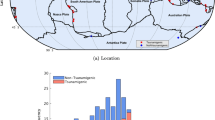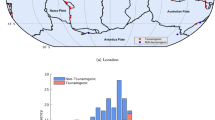Abstract
This article characterizes the regions of earthquake slip that are responsible for strong motion generation (SMG), using extreme value theory (EVT). A three-step iterative procedure involving Zipf plot, mean excess function plot and moment ratio plot is used to define the threshold value for a slip model. This threshold slip demarcates the region of SMG in the slip model. The iterative procedure ensures that slip values above the threshold slip follow generalized Pareto distribution (GPD). The regions where slip is greater than the corresponding threshold slip are defined as regions of SMG. A total of 159 slip samples filtered from the SRCMOD catalogue are analyzed in this paper. In order to identify the region of SMG, the first step is to obtain effective slip dimensions. A novel method based on strong motion duration (SMD) is proposed to obtain the effective dimensions of slip model. In the next step, the iterative procedure is employed to obtain threshold slip and the regions of SMG for all the slip samples. The corresponding area of SMG is estimated from the number of sub-faults in the region of SMG and the sub-fault dimensions. Regression analysis is carried out to establish source scaling relationships for the rupture parameters with respect to seismic moment. The considered rupture parameters are effective length, effective width, effective area, effective mean slip, threshold slip and area of SMG of the slip model. On a logarithmic scale, these rupture parameters are observed to follow a linearly increasing trend with the seismic moment. The proposed equations can be used to estimate the rupture parameters for future earthquake events.












Similar content being viewed by others
References
Aki, K. (1984). Asperities, barriers, characteristic earthquakes and strong motion prediction. Journal of Geophysical Research: Solid Earth, 89(B7), 5867–5872.
Balkema, A. A., & De Haan, L. (1974). Residual life time at great age. The Annals of probability, 792-804.
Cirillo, P. (2013). Are your data really Pareto distributed? Physica A: Statistical Mechanics and its Applications, 392(23), 5947–5962.
Dargahi-Noubary, G. R. (1986). A method for predicting future large earthquakes using extreme order statistics. Physics of the Earth and Planetary Interiors, 42(4), 241–245.
Davis, J. C. (1986). Statistics and data analysis in geology. New York: Willey.
Gnedenko, B. (1943). Sur la distribution limite du terme maximum d’uneseriealeatoire. Annals of Mathematics, 423–453
Gusev, A. A. (2011). Statistics of the values of a normalized slip in the points of an earthquake fault. Izvestiya, Physics of the Solid Earth, 47(3), 176–185.
Hanks, T. C., & Kanamori, H. (1979). A moment magnitude scale. Journal of Geophysical Research, 84, 2348–2350.
Hartzell, S. H., & Heaton, T. H. (1983). Inversion of strong ground motion and teleseismic waveform data for the fault rupture history of the 1979 Imperial Valley, California, earthquake. Bulletin of the Seismological Society of America, 73(6A), 1553–1583.
Hartzell, S., & Liu, P. (1995). Determination of earthquake source parameters using a hybrid global search algorithm. Bulletin of the Seismological Society of America, 85(2), 516–524.
Ji, C., Wald, D. J., & Helmberger, D. V. (2002). Source description of the 1999 Hector Mine, California, earthquake, part I: Wavelet domain inversion theory and resolution analysis. Bulletin of the Seismological Society of America, 92(4), 1192–1207.
Kanamori, H., & Stewart, G. S. (1978). Seismological aspects of the Guatemala earthquake of February 4, 1976. Journal of Geophysical Research: Solid Earth, 83(B7), 3427–3434.
Lavallée, D., Liu, P., & Archuleta, R. J. (2006). Stochastic model of heterogeneity in earthquake slip spatial distributions. Geophysical Journal International, 165(2), 622–640.
Mai, P. M., & Beroza, G. C. (2000). Source scaling properties from finite-fault-rupture models. Bulletin of the Seismological Society of America, 90(3), 604–615.
Mai, P. M., Spudich, P., & Boatwright, J. (2005). Hypocenter locations in finite-source rupture models. Bulletin of the Seismological Society of America, 95(3), 965–980.
Makarov, M. (2007). Applications of exact extreme value theorem. Journal of Operational Risk, 2(1), 115–120.
Papageorgiou, A. S., & Aki, K. (1983a). A specific barrier model for the quantitative description of inhomogeneous faulting and the prediction of strong ground motion. Part I. Description of the model. Bulletin of the Seismological Society of America, 73(3), 693–722.
Papageorgiou, A. S., & Aki, K. (1983b). A specific barrier model for the quantitative description of inhomogeneous faulting and the prediction of strong ground motion. Part II. Applications of the model. Bulletin of the Seismological Society of America, 73(4), 953–978.
Pavlenko, V. A. (2015). Effect of alternative distributions of ground motion variability on results of probabilistic seismic hazard analysis. Natural Hazards, 78(3), 1917–1930.
Pickands III, J. (1975). Statistical inference using extreme order statistics. The Annals of Statistics, 119–131.
Pisarenko, V. F., & Sornette, D. (2003). Characterization of the frequency of extreme earthquake events by the generalized Pareto distribution. Pure and Applied Geophysics, 160(12), 2343–2364.
Pisarenko, V. F., Sornette, D., & Rodkin, M. V. (2010). Distribution of maximum earthquake magnitudes in future time intervals: application to the seismicity of Japan (1923–2007). Earth, Planets and Space, 62(7), 567–578.
Pisarenko, V. F., Sornette, A., Sornette, D., & Rodkin, M. V. (2014). Characterization of the tail of the distribution of earthquake magnitudes by combining the GEV and GPD descriptions of extreme value theory. Pure and Applied Geophysics, 171(8), 1599–1624.
Raghu Kanth, S. T. G., & Iyengar, R. N. (2008). Strong motion compatible source geometry. Journal of Geophysical Research: Solid Earth, 113(B4).
Somerville, P., Irikura, K., Graves, R., Sawada, S., Wald, D., Abrahamson, N., et al. (1999). Characterizing crustal earthquake slip models for the prediction of strong ground motion. Seismological Research Letters, 70(1), 59–80.
Trifunac, M. D., & Brady, A. G. (1975). A study on the duration of strong earthquake ground motion. Bulletin of the Seismological Society of America, 65(3), 581–626.
Wells, D. L., & Coppersmith, K. J. (1994). New empirical relationships among magnitude, rupture length, rupture width, rupture area, and surface displacement. Bulletin of the Seismological Society of America, 84(4), 974–1002.
Author information
Authors and Affiliations
Corresponding author
Additional information
Publisher's Note
Springer Nature remains neutral with regard to jurisdictional claims in published maps and institutional affiliations.
Rights and permissions
About this article
Cite this article
Dhabu, A.C., Sugumar, S. & Raghukanth, S.T.G. Characterization of Strong Motion Generation Regions of Earthquake Slip Using Extreme Value Theory. Pure Appl. Geophys. 176, 3567–3592 (2019). https://doi.org/10.1007/s00024-019-02136-0
Received:
Revised:
Accepted:
Published:
Issue Date:
DOI: https://doi.org/10.1007/s00024-019-02136-0




